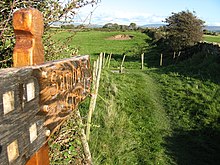BLACK SOCIAL HISTORY
Sambo's Grave
| Slavery |
|---|
 |
Sambo's Grave is the burial site of a dark-skinned cabin boy or slave, on unconsecrated ground in a field near the small village of Sunderland Point, near Heysham and Overton, Lancashire, North West England. Sunderland Point was a port, serving cotton,sugar and slave ships from the West Indies and North America, which declined after Glasson Dock was opened in 1787. It is a very small community only accessible via a narrow road, which crosses a salt marsh and is cut off at high tide.
History
In the early 18th century Sunderland Point was a port for Lancaster, serving ships too large to sail up to the town.[1]According to the Lonsdale Magazine of 1822,[2] Sambo had arrived around 1736 from the West Indies as a servant to the captain of an unnamed ship:
It has also been suggested that Sambo may have died from a disease to which he had no natural immunity, contracted from contact with Europeans.[3] He was buried in unconsecrated ground (as he was not a Christian) on the weatherbeaten shoreline of Morecambe Bay.[4]
Plaque
With the opening of Glasson Dock in 1787, trade ships deserted Sunderland Point and it became a sea-bathing place and holiday venue.[1] Sixty years after the burial, a retired headmaster of Lancaster boys' grammar school, James Watson, heard the story and raised money from summer visitors to the area for a memorial, to be placed on the unmarked grave.[1] Watson, who was the brother of the prominent Lancaster slave trader, William Watson, also wrote the epitaph that now marks the grave (note the use of 'ſ', the Long scharacter, and the eccentric and inconsistent spelling typical of the time):[5]
Here lies
Poor Samboo A faithfull Negro Who (Attending his Maſter from the Weſt Indies) Died on his Arrival at Sunderland |
Full sixty Years the angry Winter's Wave
Has thundering daſhd this bleak & barren Shore Since Sambo's Head laid in this lonely Grave Lies still & ne'er will hear their turmoil more.
Full many a Sandbird chirps upon the Sod
And many a Moonlight Elfin round him trips Full many a Summer's Sunbeam warms the Clod And many a teeming Cloud upon him drips.
But still he sleeps _ till the awakening Sounds
Of the Archangel's Trump new Life impart Then the Great Judge his Approbation founds Not on Man's Color but his_Worth of Heart
James Watſon Scr. H.Bell del. 1796
|






















































































No comments:
Post a Comment